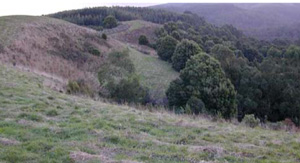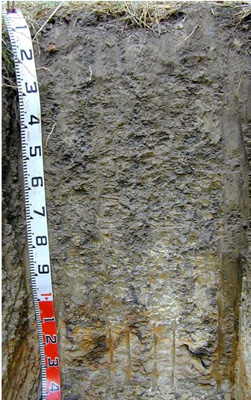COF01
 Rolling low hills near Johanna |
| COF01a |  Acidic, Eutrophic, Grey DERMOSOL (Clayey) | |
| Johanna | |||
| Rolling low hills | |||
| Neogene Hanson Plain Sand: fluvial gravel, sand , silt | |||
| Upper slopes | |||
| 26% | |||
| south-east | |||
Horizon | Depth (cm) | Description | ||
A1 | 0-20 | Dark brown (10YR3/3); light medium clay; strong fine polyhedral, parting to strong fine granular structure; weak consistence (moderately moist); pH 5.4; many medium roots; gradual and wavy boundary to: | ||
B21 | 40-80 | Dark greyish brown (10YR4/2) with common medium distinct yellowish brown (10YR5/8) mottles; medium heavy clay; moderate coarse polyhedral, parting to weak fine polyhedral structure; firm consistence (moderately moist); pH 5.3; many medium roots; gradual and wavy boundary to: | ||
B22 | 80-110 | Dark greyish brown (10YR4/2) with many medium distinct yellowish brown (10YR5/8) and very pale brown (10YR7/3) mottles; light medium clay; moderate coarse polyhedral, parting to moderate medium polyhedral structure; firm consistence (moderately moist); pH 5.1; many medium roots; clear and wavy boundary to: | ||
B23 | 110-140 | Light grey (10YR7/2) with many very coarse distinct strong brown (7.5YR5/8) mottles; light clay; massive structure; very firm consistence (moderately moist); pH 5.0; few very fine roots: | ||
140-200 | Similar to above. | |||
200-800 | Similar to above but harder, old remnant roots observed 2.5 - 3.0 m; no live roots observed; live roots observed at 2 m; notice impeding layer; roots don't like it. | |||
| Management considerations | ||||
| This soil site is acid throughout the soil profile and has high levels of exchangeable aluminium in the subsoil. Acidic subsoils generally occur on acidic parent material or where there has been sufficient leaching of the soil. These subsoils affect nutrient availability, creating a nutrient imbalance and the potential for aluminium and manganese toxicity. The application of lime is the main method of increasing the pH, reducing toxic levels of nutrients to plants while increasing the availability of nutrients such as calcium, potassium and molybdenum. Where the acidity is deep, acid tolerant plants are a practical option. | ||||
Analytical data
Site COF01 | Sample depth | pH | EC | NaCl | Ex Ca | Ex Mg | Ex K | Ex Na | Ex Al | Ex Acidity | FC –10kPa | PWP –1500kPa | KS | FS | Z | C | |
Horizon | cm | H2O | CaCl2 | dS/m | % | cmolc/kg | cmolc/kg | cmolc/kg | cmolc/kg | mg/kg | cmolc/kg | % | % | % | % | % | % |
A1 | 0-20 | 5.4 | 4.6 | 0.07 | N/R | 5.8 | 4.3 | 0.99 | 0.21 | 82 | 14 | 37.3 | 17.3 | 2.1 | 19.8 | 32.5 | 40.0 |
B21 | 40-80 | 5.3 | 4.2 | 0.06 | N/R | 5.6 | 7.2 | 1.3 | 0.27 | 300 | 14 | 39.7 | 21.5 | 0.5 | 12.5 | 28.0 | 57.0 |
B22 | 80-110 | 5.1 | 4.1 | 0.07 | N/R | 3.0 | 7.0 | 0.94 | 0.29 | 990 | 19 | 43.9 | 27.2 | 0.8 | 14.2 | 35.0 | 50.5 |
B23 | 110-140 | 5.0 | 4.1 | <0.05 | N/R | 1.4 | 5.2 | 0.50 | 0.22 | 820 | 15 | 35.6 | 11.8 | 4.2 | 48.2 | 25.5 | 19.5 |


